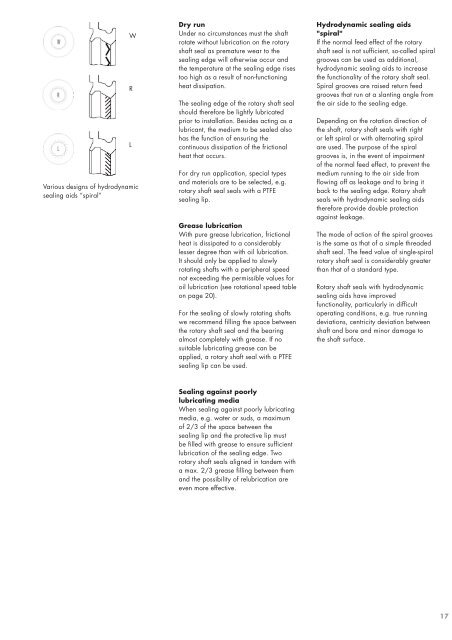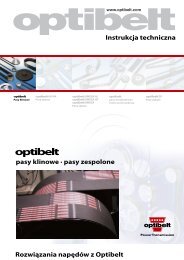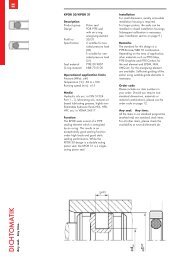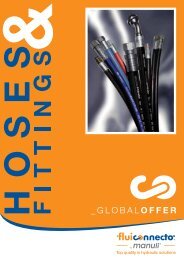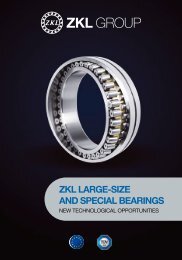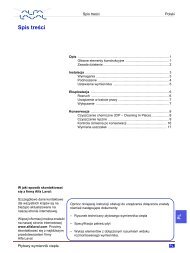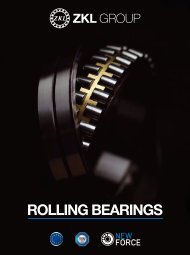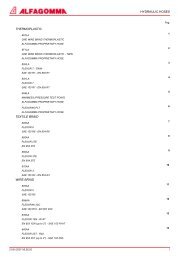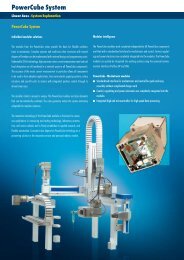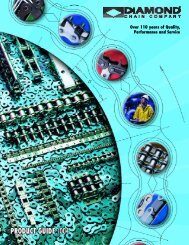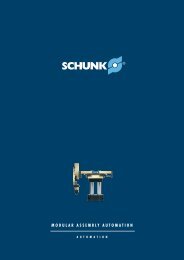DICHTOMATIK
DICHTOMATIK - Spinet
DICHTOMATIK - Spinet
- No tags were found...
Create successful ePaper yourself
Turn your PDF publications into a flip-book with our unique Google optimized e-Paper software.
W<br />
Various designs of hydrodynamic<br />
sealing aids “spiral”<br />
R<br />
L<br />
Dry run<br />
Under no circumstances must the shaft<br />
rotate without lubrication on the rotary<br />
shaft seal as premature wear to the<br />
sealing edge will otherwise occur and<br />
the temperature at the sealing edge rises<br />
too high as a result of non-functioning<br />
heat dissipation.<br />
The sealing edge of the rotary shaft seal<br />
should therefore be lightly lubricated<br />
prior to installation. Besides acting as a<br />
lubricant, the medium to be sealed also<br />
has the function of ensuring the<br />
continuous dissipation of the frictional<br />
heat that occurs.<br />
For dry run application, special types<br />
and materials are to be selected, e.g.<br />
rotary shaft seal seals with a PTFE<br />
sealing lip.<br />
Grease lubrication<br />
With pure grease lubrication, frictional<br />
heat is dissipated to a considerably<br />
lesser degree than with oil lubrication.<br />
It should only be applied to slowly<br />
rotating shafts with a peripheral speed<br />
not exceeding the permissible values for<br />
oil lubrication (see rotational speed table<br />
on page 20).<br />
For the sealing of slowly rotating shafts<br />
we recommend filling the space between<br />
the rotary shaft seal and the bearing<br />
almost completely with grease. If no<br />
suitable lubricating grease can be<br />
applied, a rotary shaft seal with a PTFE<br />
sealing lip can be used.<br />
Hydrodynamic sealing aids<br />
"spiral"<br />
If the normal feed effect of the rotary<br />
shaft seal is not sufficient, so-called spiral<br />
grooves can be used as additional,<br />
hydrodynamic sealing aids to increase<br />
the functionality of the rotary shaft seal.<br />
Spiral grooves are raised return feed<br />
grooves that run at a slanting angle from<br />
the air side to the sealing edge.<br />
Depending on the rotation direction of<br />
the shaft, rotary shaft seals with right<br />
or left spiral or with alternating spiral<br />
are used. The purpose of the spiral<br />
grooves is, in the event of impairment<br />
of the normal feed effect, to prevent the<br />
medium running to the air side from<br />
flowing off as leakage and to bring it<br />
back to the sealing edge. Rotary shaft<br />
seals with hydrodynamic sealing aids<br />
therefore provide double protection<br />
against leakage.<br />
The mode of action of the spiral grooves<br />
is the same as that of a simple threaded<br />
shaft seal. The feed value of single-spiral<br />
rotary shaft seal is considerably greater<br />
than that of a standard type.<br />
Rotary shaft seals with hydrodynamic<br />
sealing aids have improved<br />
functionality, particularly in difficult<br />
operating conditions, e.g. true running<br />
deviations, centricity deviation between<br />
shaft and bore and minor damage to<br />
the shaft surface.<br />
Sealing against poorly<br />
lubricating media<br />
When sealing against poorly lubricating<br />
media, e.g. water or suds, a maximum<br />
of 2/3 of the space between the<br />
sealing lip and the protective lip must<br />
be filled with grease to ensure sufficient<br />
lubrication of the sealing edge. Two<br />
rotary shaft seals aligned in tandem with<br />
a max. 2/3 grease filling between them<br />
and the possibility of relubrication are<br />
even more effective.<br />
17


